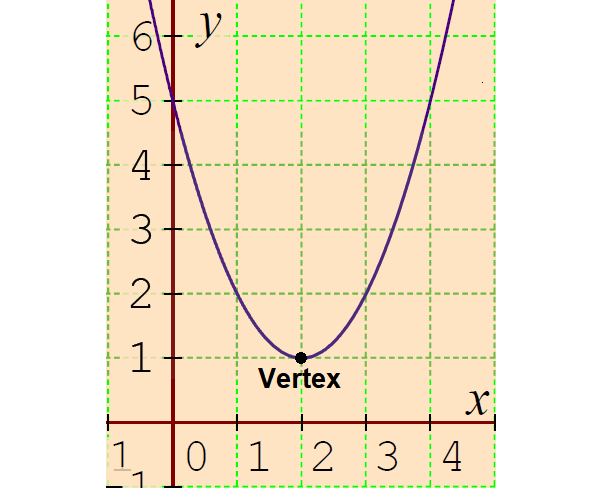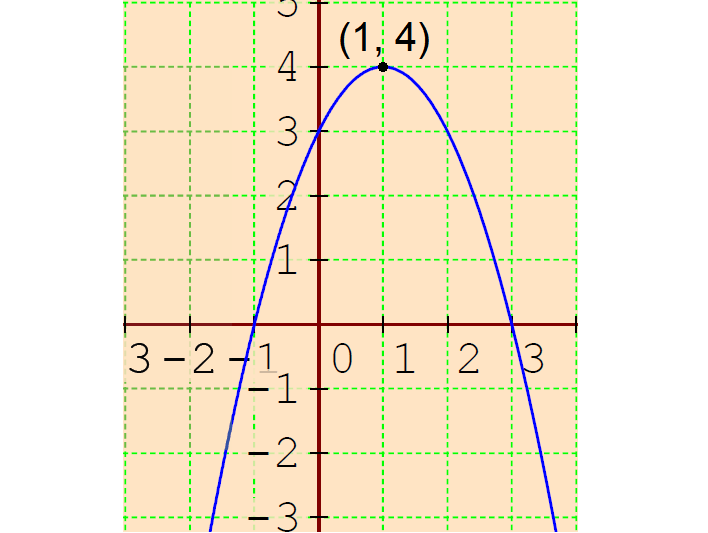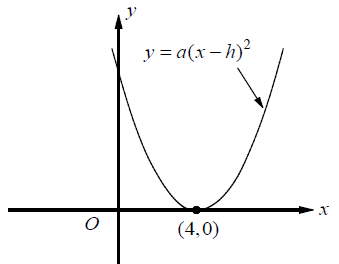VERTEX FORM OF A QUADRATIC EQUATION
Subscribe to our ▶️ YouTube channel 🔴 for the latest videos, updates, and tips.
Learning Objectives :
* Vertex form of a quadratic equation.
* If a quadratic equation is given in standard form, how to write it in vertex form.
* How to sketch the graph of a quadratic equation that is in vertex form.
Vertex form of a quadratic equation :
y = a(x - h)2 + k
where (h, k) is the vertex of the parabola.
The h represents the horizontal shift and k represents the vertical shift.
Horizontal Shift :
Shifting the graph of the parent function y = x2 to the left or right from x = 0.
Vertical Shift :
Shifting the graph of the parent function y = x2 up or down from x = 0.

In the above picture, the graph (Parabola) of the parent function y = x2 is shifted 2 units to the right from x = 0 and 1 unit up from y = 0.
So, the vertex is
(Horizontal shift, Vertical shift) = (2, 1)
Example 1 :
Write the quadratic equation in vertex form and write its vertex :
y = -x2 - 2x - 2
Solution :
Vertex form of the quadratic equation :
y = -x2 - 2x - 2
y = -(x2 + 2x) - 2
y = -[x2 + 2(x)(1) + 12 - 12] - 2
y = -[(x + 1)2 - 12] - 2
y = -[(x + 1)2 - 1] - 2
y = -(x + 1)2 + 1 - 2
y = -(x + 1)2 - 1
Vertex :
Comparing y = a(x - h)2 + k and y = -(x + 1)2 - 1,
h = -1 and k = -1
So, the vertex is (h, k) = (-1, -1).
Example 2 :
Write the quadratic equation in vertex form and sketch the graph.
y = -x2 + 2x + 3
Solution :
Vertex form of the quadratic equation :
y = -x2 + 2x + 3
y = -(x2 - 2x) + 3
y = -[x2 - 2(x)(1) + 12 - 12] + 3
y = -[(x - 1)2 - 12] + 3
y = -[(x - 1)2 - 1] + 3
y = -(x - 1)2 + 1 + 3
y = -(x - 1)2 + 4
Vertex :
Comparing y = a(x - h)2 + k and y = -(x - 1)2 + 4,
h = 1 and k = 4
So, the vertex is (h, k) = (1, 4).
To graph the above quadratic equation, we need to find x-intercept and y-intercept, if any.
x-intercept :
To find the x-intercept, substitute y = 0.
0 = -(x - 1)2 + 4
(x - 1)2 = 4
Take square root on both sides.
x - 1 = ±√4
x - 1 = ±2
x - 1 = -2 or x - 1 = 2
x = -1 or x = 3
So, the x-intercepts are (-1, 0) and (3, 0) .
y-intercept :
To find the y-intercept, substitute x = 0.
y = -(0 - 1)2 + 4
y = -(-1)2 + 4
y = -1 + 4
y = 3
So, the y-intercept is (0, 3).
Comparing y = a(x - h)2 + k and y = -(x - 1)2 + 4,
a = -1
So, the parabola opens down with vertex (1, 4), x-intercepts (-1, 0) and (3, 0) and y-intercept (0, 3).

Example 3 :
Given f(x) = x2 + 2x - 2, find the following.
a) y-intercept b) Axis of symmetry
c) The coordinate of the vertex
d) Idnetify the vertex as a maximum or minimum.
Solution :
f(x) = x2 + 2x - 2
a) y-intercept :
Put x = 0
f(x) = y
y = 02 + 2(0) - 2
y = -2
b) Axis of symmetry
Equation of axis of symmetery x = -b/2a
a = 1, b = 2 and c = -2
x = -2/2(1)
x = -1
c) The coordinate of the vertex
f(x) = x2 + 2x(1) + 12- 12 - 2
= (x + 1)2 - 1 - 2
f(x) = (x + 1)2 - 3
Comparing with y = (x - h)2 + k
we get (h, k) ==> (-1, -3). So the vertex is at (-1, -3)
d) Identify the vertex as a maximum or minimum.
Since the parabola opens up, it may have minimum at x = -1 and the minimum value is -3.
Example 4 :

In the xy-plane above, the parabola y = a(x - h)2 has one x-intercept at (4, 0). If the y-intercept of the parabola is 9, what is the value of a ?
Solution :
Applying the vertex in the equation above,
y = a(x - 4)2
y-intercept of the parabola is 9, then we know that the parabola will pass through the point (0, 9).
9 = a(0 - 4)2
9 = a(- 4)2
9 = 16a
a = 9/16
So, the value of a is 9/16.
Example 5 :
In the xy-plane, if the parabola with equation
y = a(x + 2)2 - 15
passes through (1, 3), what is the value of a ?
Since the parabola passes through the point (1, 3), we apply x = 1 abd y = 3 in the equation above.
3 = a(1 + 2)2 - 15
3 + 15 = a(3)2
18 = 9a
a = 18/9
a = 2
So, the value of a is 2.
Subscribe to our ▶️ YouTube channel 🔴 for the latest videos, updates, and tips.
Kindly mail your feedback to v4formath@gmail.com
We always appreciate your feedback.
About Us | Contact Us | Privacy Policy
©All rights reserved. onlinemath4all.com

Recent Articles
-
US Common Core K-12 Curricum Algebra Solving Simple Equations
Jan 07, 26 01:53 PM
US Common Core K-12 Curricum Algebra Solving Simple Equations -
10 Hard SAT Math Questions (Part - 4)
Jan 05, 26 06:56 PM
10 Hard SAT Math Questions (Part - 4) -
10 Hard SAT Math Questions (Part - 3)
Jan 05, 26 06:34 PM
10 Hard SAT Math Questions (Part - 3)

